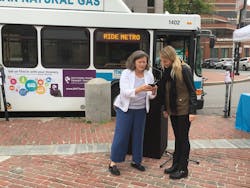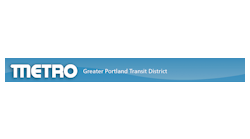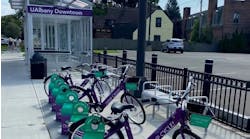The Greater Portland Transit District (Metro) in Portland, Maine, is growing to accommodate the future of passenger information. In 2016 the agency celebrated reaching a record ridership of 1.81 million; 2016 was a 15 percent increase at 1,810,825 from the 1,568,136 reached in 2015. In January of 2017, Metro announced that they were working to implement programs and system changes to improve its overall service and system infrastructure.
Denise Beck, Metro marketing director, said that Metro listens to its riders during public meetings and workshops. Beck explained that they began working on changes in around 2013 when Greg Jordan joined Metro as the system's general manager. The began doing a review first of Metro's bus stops and increasing service.
"What we did was get rid of quite a few so that we could improve frequency for our system, but we also wanted to be mindful of our entire systems. Since then we’ve done a lot of other things. We’ve increased our service, we had very limited service on Sunday and we added additional Sunday service in 2015 — we increased all of our routes to have Sunday service. It’s still limited, but it is improving," explained Beck. "We’ve increased bus shelters. Last year we added nine lighted shelters and we’re adding another 15 this year."
From there Metro looked to further make its system easy to navigate for passengers.
"We added real-time bus information. We didn’t have that, I know that a lot of transit agencies do, but we didn’t so we were pretty excited to get it," said Beck.
Developing Passenger Signage
Metro has partnered with local businesses to relay passenger information such as promotions. One example is where the agency partnered with Creative Portland and Portland Downtown for the First Friday Art Walk — for big events Metro works with local businesses to have their information on their websites.
"Our downtown isn’t as crazy as some, but parking is a hassle so we’re promoting take the bus into downtown when there is a big event," said Beck.
Real-time bus information has been a real asset to Metro since implementing it. Metro had riders asking for the service during public meetings.
"We just kicked off the real-time bus information last June. There is a website that has planning information for real-time and riders can download smart apps as well or texts from bus stops," explained Beck. The available app for riders is an open-sourced app. "We talked a lot about developing it and decided that we would have it open-sourced. That way if there are changes the market can take care of those and have them available on different types of formats. Right night we have it on Google, Transit App and Moovit."
When planning towards the future Metro is looking to have real-time information displayed directly in its bus shelters.
"Right now we don’t have the information in bus shelters, that is certainly something that we are planning in the future," Beck said. "In 2018 and 2019 we want to put the digital displays in bus shelters and other locations."
Metro also looks to display updated route information in its shelters as well. In 2015 Metro partnered with local Portland high schools, students now take the agencies route to school.
"As part of our partnership with the schools we just installed some new shelters in those areas. Our plan is to rework the maps and have displays of the routes in the shelters by the end of the year," said Beck.
Besides helping the next generation gain a taste for transit, students also have the ability to use the real-time technology to accurately plan their trips. As younger generations come to the age where they are able to navigate transit on their own, relaying passenger information through technology has the ability to make transit even more attractive. Metro has its riders in each area of the system fill out surveys as to their response to system changes. Beck thinks that that will be a great opportunity to discover how the passenger information system has benefited them.
"Riders wanted it and they asked for it, they have defiantly used it."
Fare Collection
Being a smaller system, Beck said that they've been working on their long-term plan to further develop Metro's system. In 2018 the agency plans to implement electronic fare collection. With so many options in the fare collection world Metro is currently in the research phase. "We need to figure out what works for this system and what is affordable. It is going to be a huge change when we change to electronic fare media. Right now we are very old school, so when we change we have to be very mindful of do we go to the next step and to see where we should go with it so we don’t have to change it again."
Fare collection was another factor that was brought up by riders during the public meetings.
"They’ve been asking about that for years because it’s been available in larger systems," said Beck. As the topic of fare collection is in the developmental stages, Metro has yet to decide what route they would like to take. Beck said that they have people from Metro going to fare collection seminars to determine which would work best.
Acquiring Funds and Looking to the Future
The age-old question is how to acquire funds. Metro is working in the agencies long-term plan of what to implement when they have the available funding. Beck said that Jordan works to plan what the agency wants with what sort of grants and funds are available. Beck said that Metro also plans years in advance as to what options the agency can look towards in the near future.
"Providing what our riders want with frequency and information and the schedules that they want is of primary importance. We go out and ask them and kind of give them the option of is it more important for them to have service frequency, lower fares or if there is something else that is more important. We can really gauge what our riders want," said Beck.
As for what Metro has done in passenger information thus far Beck things that the real-time passenger information has been the most beneficial. "Being able to find your bus is huge. We are not a really large system so we don’t have 10-minute service like a larger city. On some route it’s half an hour or an hour between buses. In a case like that you want to know that you’ve missed your bus. For a rider to know when the next bus is coming is very important and I think that it helps them make the decision if they are going to ride transit."
Beck said that Metro also wants to add digital shelters along with announcements in the agency's buses. "We’re just trying to get out more and have people think of transit so it’s more top of mind than it used to be and we want to be out in front of people more than we used to be."



